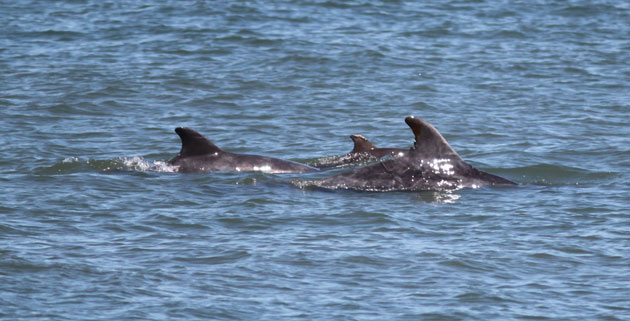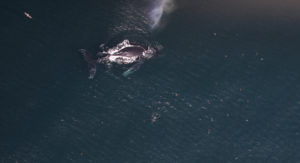About 60 coastal bottlenose dolphins have been spotted traveling from Southern California to the waters off Bodega Bay, pushing the northern limit of their range and leaving the scientists who study them with a mystery: Long distance migrations aren’t unusual for marine mammals, but these dolphins aren’t making seasonal swims. Instead, says Bill Keener, a marine mammal biologist at Golden Gate Cetacean Research, the dolphins seem to be traveling up and down the coast without any sort of schedule.
Scientists have tracked the long-range swimmers with telephoto lenses by using close-up photos of the unique nicks and notches on the silhouette of each dolphin’s dorsal fin to compile a catalog of dolphin IDs. The questions arose when San Francisco Bay researchers checked their images against photo entries in a catalog kept by scientists farther down the coast, and discovered a lot of matching images.
“Finding 10 percent of the entire West Coast stock here is kind of unexpected,” Keener said. “But we also don’t know what is spurring them to keep moving.”
Dolphin skulls dating from long, long ago have been dredged up from San Francisco Bay. But in modern times, dolphins weren’t sighted north of Point Concepción – the land that juts into the Pacific just west of Santa Barbara – until the 1982 El Niño carried warm currents and a supply of fish up the coast. Then, the gregarious cetaceans were spotted off the San Mateo coast. When the water turned cool again, some of the dolphins stayed instead of retreating to their old stomping grounds in Southern California.
About six years ago the bottlenose dolphins started to show up regularly in the Bay, said Izzy Szczepaniak, a marine biologist at GGCR. Reports of the coast-hugging cetaceans came from the Golden Gate Bridge and Redwood City. Dolphins got stuck in the shallow waters of Colma Creek and again in the mudflats south of San Francisco Airport.
“We don’t know how far they can travel in a day,” said Mark Cotter, field director for the California Coastal Dolphin Project and vice president of Okeanis, a nonprofit marine mammal research organization based in Moss Landing. That said, Cotter knows that the animals can show some hustle: One August day in 2011, two dolphins called Rambo and Oro were sighted off the Golden Gate Bridge by Keener and Szczepaniak, and then two days later Cotter saw the same pair swimming in Monterey Bay.
The dolphin they call “Smootch” could be the poster dolphin for the northward range expansion. Her dorsal fin photo has been in the California Dolphin Online Catalog (CDOC) for decades. She was first photo-tagged in 1984 by San Diego researchers. Since then she’s been photographed in six sites – once with a calf to give researchers a clue about her gender – ranging from Ensenada, Mexico to Bodega Bay. Smootch’s swims are the longest distance ever recorded for a coastal bottlenose dolphin.
“This is not a migration. These dolphins are moving weekly and they aren’t always taking short trips,” said R.H. Defran, a San Diego researcher who has studied the dolphins for decades. He is organizing CDOC into an online resource that will make it easier for researchers to collaborate and find answers for the dolphins’ puzzling lifestyle.
The California dolphins do things differently than their Atlantic Seaboard counterparts. On the East Coast and in the Gulf of Mexico the dolphins lead a more residential lifestyle, staying in smaller schools and rarely straying from the bays and estuaries that provide mullet, squid, and small flatfish to eat.
Here, the dolphins’ habit is to move up and down the coast until they find food, said Defran. Then they hang around and exploit it. When the food thins out, the dolphins continue on elsewhere. It may be that the chance to make a living over a longer distance is a better option than sharing food over a shorter distance. “We can’t yet say what drives the dolphins’ micromanagement decisions about food,” he said. “But, they wouldn’t do it if it didn’t pay off.”
Although the dolphins have strong food preferences they are also behaviorally “plastic,” meaning they are good at adapting to new circumstances, Defran said. Dolphins will team up to herd schools of anchovies or herrings. They’ll break off into groups of two or three to chase down halibut, rockfish, or capelin. They can also “kerplunk” – smacking their fluke or fins on the water to stun larger fish. Researchers even photographed dolphins dining on Chinook salmon in the Bay.
But food may not be the only reason for the dolphins’ northward movement. It could be about culture, said Defran. The dolphins have a “fission-fusion society” in which bonds are very fluid. Most of the animals have probably crossed paths at some point. Defran theorizes that the abrupt range expansion resulting from the El Nino exposed older members of some social groups to the sustainability of more northern waters. In turn, these more senior dolphins may have exerted some influence over the geographic preferences of younger generations. There’s good evidence that dolphins develop cultural preferences. In Western Australia the dolphins use sponges to protect their sensitive chins when they forage and they pass that skill from mother to daughter.
With more photos and collaboration among colleagues up and down the coast, the scientists hope to understand why the dolphins are moving so much. The CDOC may also help figure out another surprising phenomenon among these coastal dolphins: porpicide.
For reasons that researchers don’t yet understand, dolphins have been ganging up on harbor porpoises and causing enough blunt force trauma to drown the smaller cetaceans. In 2008-2009 there was a significant increase in porpoise strandings; almost half of those were associated with blunt force trauma consistent with dolphin attacks, based on necropsies performed at The Marine Mammal Center in Sausalito. One episode was caught on video by Cotter’s colleagues from Monterey Bay. If they were able to get photographs that showed the same dolphins were involved in porpoise attacks, that might suggest that aggression was part of a cultural transmission, a behavior that could be shared – and spread – among dolphins.
Although scientists figure there are about 500 coastal dolphins in California, the catalog can never be definitive. Dorsal fins aren’t like fingerprints. The animals get fin notches from a variety of sources: rubbing on pier pilings, brief entanglements with fishing lines, or social interactions – scars from rake marks – with each other. Some dolphins are “smooth”; they don’t have any unique marks that can be tracked, while others may have notches that change over the years. Smootch added a new notch to her fin in 2012 but is still, fortunately, identifiable by her original fin profile taken in 1984.
The photo IDs for the Bay Area dolphins should be integrated into the CDOC before the end of this summer. Then the next step is to see if there are any other long-distance swimmers like Smootch, said Szczepaniak. He’s looking forward to catching sight of Smootch again, too.
Citizen scientists can send bottlenose dolphin sightings in the Bay Area to Golden Gate Cetacean Research by going to www.ggcetacean.org and filling out the sightings report form.




-300x89.jpg)
-300x199.jpg)